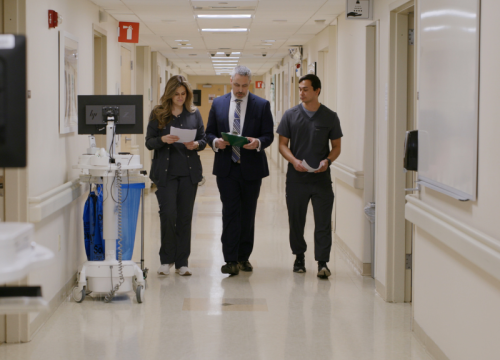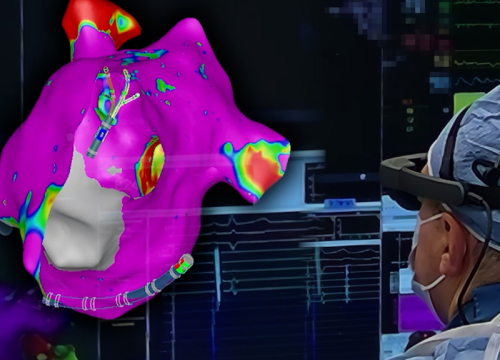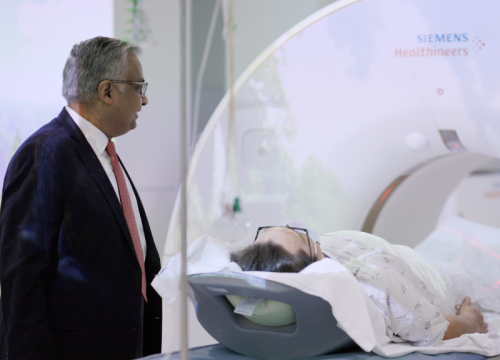Highly qualified, certified sonographers at Valley’s Center for Maternal-Fetal Medicine perform precise ultrasounds to help predict and diagnose any situation that might arise during a pregnancy. A sonogram is the image created by an ultrasound.
Our patients benefit from early diagnosis and treatment of complex prenatal complications, as well as routine gynecologic ultrasound. Below are some of the ultrasounds you may have.
Note: Not all birth defects can be identified while you are pregnant.
Prenatal Ultrasound
First Trimester Screening With Nuchal Translucency
- This is an ultrasound examination performed between 11 and 14 weeks gestation.
- Our sonographers take a measurement of the clear space in the tissue at the back of the baby’s neck. The presence or absence of the fetal nasal bone is also documented. (An absent nasal bone may be associated with an increased risk for chromosomal abnormalities.)
- These results are combined with your age and a special blood test to determine if your pregnancy is at increased risk for certain chromosomal abnormalities such as Down syndrome.
- This ultrasound can also detect some (but not all) birth defects, such as whether your baby is at an increased risk for heart abnormalities.
Initial Anatomy
- This ultrasound is most often performed between 14 and 16 weeks.
- Your baby’s anatomy is evaluated for possible birth defects.
Follow-Up Anatomy
- This ultrasound is most often performed between 20 and 22 weeks.
- Your baby’s anatomy is re-evaluated for possible birth defects due to the fact that your baby’s anatomy can be better visualized at this point. Likewise, parts of the baby are still developing.
Viability/Dating
- This is an ultrasound examination most often performed in the first trimester (before 14 weeks gestation).
- It determines if the pregnancy is growing properly within your uterus.
- It also checks to make sure your ovaries are healthy.
- A first trimester ultrasound is the best time to establish your due date.
Growth
- A growth ultrasound is performed to determine an estimated weight for your baby.
- This exam may be ordered if the doctor feels that your baby may be larger or smaller than expected or if you have a medical condition necessitating that the doctor keep track of the baby’s weight.
- Note: This weight is an “estimate.” Actual birth weight and estimated fetal weight can differ.
Biophysical Profile (BPP)
- This ultrasound examination is used to assess the health of your baby.
- Movement, tone, breathing efforts and amniotic fluid volume are checked to help determine how well your baby is doing in your uterus.
- This test may be performed if you aren’t feeling your baby move as often as you did previously or if you or the baby has a medical condition requiring such evaluation.
Cervical Length
- A cervical length ultrasound measures the length of your cervix.
- You may need this test if you are having symptoms of preterm labor, such as contractions or pressure, or if you have a previous history of preterm labor and/or preterm delivery.
Doppler Studies
- Doppler studies are a special ultrasound of the maternal, placental or fetal vessels.
- They are used to determine if your pregnancy is at risk for problems or to determine the health of your baby in utero.
- These tests are only obtained if you or the baby has a condition requiring these tests.
Placental Check
- This ultrasound may be used to identify the location of your placenta.
- Your doctor may order this test if you have a history of vaginal bleeding or if your placenta looks like it may be near your cervix.
Multiple Gestation Imaging
- For the most part, the ultrasound examinations for patients with twins, triplets and high-order multiples are the same as for patients who are pregnant with one baby.
- However, patients with multiples often undergo more ultrasounds due to the fact that they may need to be monitored for signs and symptoms of preterm labor and delivery, as well as growth issues among co-twins.
Fetal Echo
- Fetal echocardiography is the use of noninvasive ultrasound techniques to assess the structure and function of an unborn baby’s heart.
- Fetal echo helps physicians analyze and diagnose congenital heart defects.
- This test may be needed if you have a family history of congenital heart defects or if it is difficult to visualize all of the parts of the heart at the time of routine anatomical screening.
3D Ultrasound
- 3D ultrasound may be used to better visualize certain anatomical parts of your baby.
- For instance, it may be used if a birth defect is suspected.
Gynecologic Ultrasound
GYN Ultrasound
- A gynecologic, or GYN, ultrasound is used to evaluate pelvic organs, including the uterus, endometrium and ovaries.
- Your doctor may order a GYN ultrasound if you have a history of ovarian cysts or uterine fibroids. Or, your doctor may order this test if you have a history of pelvic pain, vaginal bleeding, infertility or miscarriage.
Hysterosonogram, or Saline Infusion Sonogram (SIS)
- An SIS is a GYN ultrasound where a small amount of sterile saline is placed within your uterus to better evaluate the endometrial lining.
- Your doctor may order this test if you have a history of abnormal and/or irregular vaginal bleeding or if your doctor suspects that you might have polyps or fibroids within your endometrial cavity.
- SIS is sometimes performed if a patient has a history of multiple miscarriages or infertility.
- It can also be used to help determine if your uterus is shaped normally (i.e., that you do not have uterine malformation).
3D GYN Ultrasound
- 3D GYN ultrasound may be performed if a uterine anomaly is suspected.
- Sometimes it is used to evaluate polyps and fibroids within the endometrial cavity.
GYN Doppler Ultrasound
- Doppler ultrasound may be used at the time of GYN ultrasound if a cyst or polyp is noted.
















